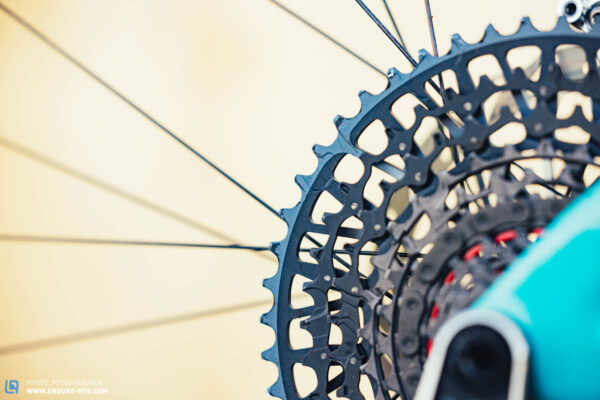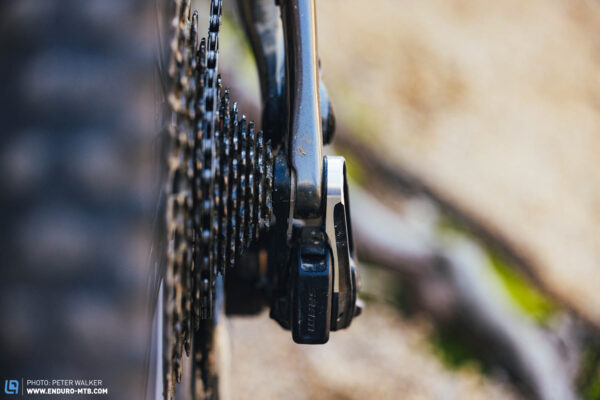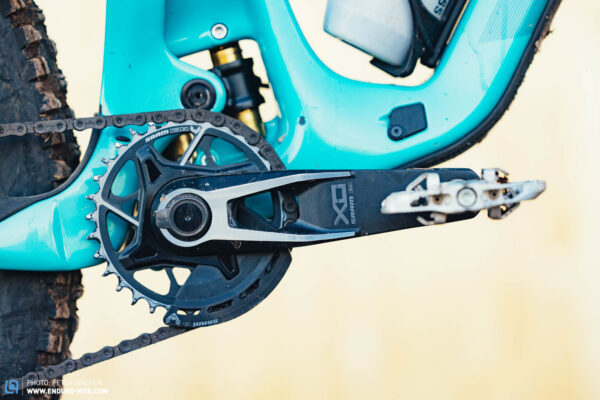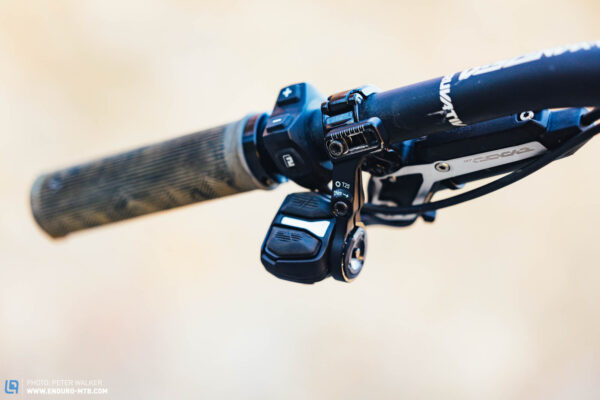The bike industry is full of wild new products with no real added value, but the idea of replacing the derailleur hanger with the new SRAM Eagle Transmission groupset while also getting rid of the adjustments has potential. The new Hangerless groupset also promises to be more robust while offering improved shifting. But what does this mean for your frame?

Mountain bikes have come a long way and they don’t seem to stop evolving. In the last 20 years, almost every part of a bike has been revised, making them more efficient, lighter and, above all, more robust. The drivetrain and especially the rear derailleurs and corresponding cassettes have undergone significant improvements, offering huge gear ranges, and fast, reliable shifting. However, the derailleur hanger continues to serve as an interface between the derailleur and the frame, and while it, too, has undergone further development, it increasingly struggles with the large gear range of modern derailleurs.
In addition, there’s an extremely wide range of different derailleur hangers on the market, because almost every bike model uses its own design. This is also the reason for the countless adjustment options of conventional rear derailleurs. Because of the different derailleur hanger designs, the position between the rear derailleur and the cassette is specific to each bike model, and the derailleur must be adjusted accordingly. This is the only way to ensure fast and reliable shifting. At some point or other, most of us will have had to fiddle with the upper and lower stops or the B screw – responsible for the distance between the upper pulley and the cassette – because the rear derailleur wouldn’t perform as it should. Never mind the fact that derailleur hangers can bend just from your bike tipping over, rendering the derailleur useless – annoying!


These problems also annoy the brands themselves because annoyed customers will come knocking at the doors of bike shops and service trucks and flood their inboxes with complaints. Fortunately, SRAM have now tackled this issue – their new Eagle Transmission derailleur mounts directly to the thru-axle, no derailleur hanger or adjustments needed thanks to the Hangerless Interface. Read on to find out how it works, what it means for your frame, and how it fared during the last 6 months in our long term review.

The new SRAM Eagle Transmission is based on the UDH derailleur hanger
Unfortunately, you can’t just omit the derailleur hanger and attach the derailleur directly to your bike. That would be too easy. Fortunately, SRAM have been thinking about this for a long time and have taken all the necessary steps to realise this design. Industry insiders and keen readers already knew what SRAM was up to when they presented the Universal Derailleur Hanger in 2019 – UDH for short. The open-source derailleur hanger was marketed as an easily replaceable and universal solution. With success: many manufacturers have since embraced the new interface and designed their frames (more precisely, dropouts) in such a way as to accommodate a UDH derailleur hanger. To date, there are over 200 mountain bike models that rely on the UDH system as an interface between the frame and the rear derailleur. By doing so, SRAM have standardised what the dropout should look like, giving them the opportunity to design a rear derailleur that fits this exact design. This ensures that it always sits in the same place in relation to the cassette and so it’s always perfectly aligned. Therefore, any stop and distance settings are redundant, and the fragile derailleur hanger is a thing of the past. Conversely, however, this also means that the new direct mount groupset can only be fitted on bikes that use the UDH system. However, the rear derailleur isn’t bolted to the frame – as it was in the past, via the derailleur hanger – but coaxially to the thru-axle and hub. Thanks to the new Hangerless Interface, the Transmission derailleur sits approximately 8–10 mm further inside compared to a conventional AXS derailleur.



How does the new SRAM Eagle Transmission groupset work?
In principle, the basic function of the new Eagle Transmission derailleur isn’t much unlike that of previous AXS models. The all-new derailleur nudges the chain inwards or outwards, depending on whether you want to shift up or down. The cassette does the actual work. Cassettes have long had so-called shifting ramps, which look like recesses on the sides of the cogs, and they’re there to help the chain climb onto a bigger cog when shifting up. However, the emphasis here is on help, because these shifting ramps are simply bypassed if the derailleur forces the chain onto the next cog, which is especially likely with mechanical derailleurs or if you’re shifting several gears at once. In addition, the chain isn’t always perfectly engaged with the cassette and, above all, an incorrectly set B-gap causes poor shifting. Therefore, you shouldn’t shift under load with conventional derailleurs if you want clean shifting, because the chain doesn’t always engage perfectly with the cogs, causing it to slip or go into the wrong gear – not to mention the wear and tear of improper shifting.


SRAM also rely on shifting ramps for their new Eagle Transmission cassettes. However, this is less of an aid and much more of a determinant for when the chain shifts. The chain won’t shift gears without the help of a shifting ramp. Depending on the gear, the new Transmission cassette has a different number of shifting ramps, which are responsible for shifting either up or down. SRAM also rely on many other practical features to optimise the shifting process. The sprockets of the new Eagle Transmission cassettes utilise the narrow-wide design, with alternating narrow and wide teeth. Until now, it was only the three inner cogs of SRAM cassettes that had narrow-wide teeth. In addition, the new Flattop chain can only mesh with the cassette in a certain position, ensuring that it is always perfectly engaged and distributing the pedalling forces equally. If it does end up in the wrong position, it won’t mesh with the cog and will simply slip back into the correct position as soon as you apply a light load. Due to the omission of the B screw, the distance between the upper guide pulley and the cassette is always correct, too.
If you shift just one gear, the alignment between the derailleur and the cassette requires the derailleur to move only to such an extent that the chain uses a single shift lane to jump up or down the cassette, preventing it from being forced into the wrong gear. The best part comes with shifting several gears at once, because the new Transmission derailleur has a programmed delay between shifting operations. For example, if you shift two or three gears in quick succession, the derailleur won’t move at the same speed but rather time the shifting. This allows the chain to wait for a shifting ramp on the cassette instead of being forced up or down the cassette.

If you shift more than three gears in quick succession, the shifting process is noticeably delayed, ensuring that the chain is always securely meshed with a maximum of two different cogs, thus allowing you to keep pedalling at full force without putting your drivetrain at risk. Due to this delay, it skips shifting ramps and thus allows the chain to catch up before starting the next shift. However, the shifting speed – or rather the delay – differs depending on which gear you’re shifting from and the number of gears you’re shifting. As the chain shifts from one gear to the next using a shifting ramp, it remains fully engaged with the cassette, it’s just that one section of the chain is on one cog and the other section is on a different cog. However, you can continue applying full power, because the continuous engagement of the chain while shifting guarantees that it won’t slip and there’s no interruption in power transfer. Conversely, however, this also means that the new Eagle Transmission groupset is slightly slower at shifting than a conventional groupset – at least if you’re shifting more than one gear at a time. This isn’t bad per se because you can continue pedalling unhindered. However, if you pedal very slowly, i.e. under about 60 revolutions per minute, you might be able to get the chain to span more than two cogs at once and thus interrupt its secure engagement because the programmed delay wouldn’t be long enough to skip a shifting ramp, initiating the next shift before the previous one has completed.
The variants of the new SRAM Eagle Transmission groupset
SRAM introduced their Eagle ecosystem in 2016, making most of the components cross compatible with each other, whether NX, GX, X0 or XX1. However, this doesn’t apply to the new Eagle Transmission groupset, because it relies on the new T-Type system that can’t be combined with previous Eagle models. Of course, all new Transmission models that rely on T-Type system are cross compatible. To start off, there will be three groupset models. The X0 groupset marks the entry, followed by the XX and XX SL groupsets. The XX SL range is aimed at cross-country use while the X0 and XX groupsets are intended for rougher trail and enduro riding and eMTBs.


The rear derailleurs of the new SRAM Eagle Transmission groupsets
With all three rear derailleurs, the cages can be removed to be replaced or serviced without tools. As with the previous AXS rear derailleurs, all Transmission rear derailleurs come with the so-called overload clutch, which allows it to fold inwards in the event of a crash or when slamming into obstacles on the trail. Now you no longer have to worry about bending the derailleur hanger either. In addition, all derailleurs can rotate upwards against the direction of travel – which used to be taken care of by the UDH derailleur hanger. Due to this, however, it’s more important than ever that you tighten the derailleur according to the specified torque. You can find information about this in our installation guide.


Using the laser etched lines on the rear derailleur, you can see if it has twisted or is still aligned properly. Don’t worry, the cages of the new derailleurs are angled on purpose as this is said to optimise the alignment with the chainring. The XX SL and XX rear derailleurs feature a so-called Magic Pulley. This refers to the lower jockey wheel, which has a protective function to keep your derailleur from getting sucked into the rear wheel. If a branch or the like gets caught in the pulley, the teeth with which the chain is engaged can simply keep spinning while the inner part remains still – cool! In the event of damage, the outer strut of the parallelogram on the X0 and XX derailleurs can be replaced. In addition, the X0 and XX models make use of plastic skid plates that are attached to the outside of the derailleur, absorbing most of the impacts it’s bound to encounter. They’re replaceable too, so you can keep your drivetrain looking fresh. The only remaining adjustment option is the well-known MicroAdjust function, which lets you adjust the derailleur inwards or outwards with the help of the controllers. However, it only has 14 settings instead of 30 as before. As usual, you can customise the functionality of your derailleur in the AXS app, activating the Multishift function, for example.



The cassettes of the new SRAM Eagle Transmission groupsets
All new Eagle Transmission groupsets rely on cassettes with a 520% gear range, as already introduced on previous SRAM groupsets. So, the smallest sprocket still has 10 teeth and the largest has 52 teeth. However, the gear steps have been adjusted slightly with the third and second gear using 38 and 44 teeth respectively, instead of 36 and 42 teeth as before. This will allow for a more pleasant transition between the top gears. SRAM won’t be offering a Transmission cassette with a 500% range for the time being. As before, all cassettes can be fitted to XD freehubs. There’s a red plastic sleeve marking the sixth gear which is used for the setup. The large 52 t cog is made of aluminium on all three cassettes. The 44 and 38 t cogs on the XX SL cassette are also made of aluminium to reduce weight. On the X0 and XX cassettes, these two cogs are made of stamped steel. The remaining 9 cogs of all three models are machined from one piece of steel. The only difference here is the Dark Polar finish of the X0 cassette. There’s no difference between the XX and XX SL cassettes in terms of finish.


The chains of the new SRAM Eagle Transmission groupsets
All new Eagle Transmission groupsets rely on the use of a steel Flattop chain, which – as the name suggests – has a flat top. It’s unidirectional and can only mesh with the cogs in one position. The XX SL chain has additional cut-outs in the chain links to save weight. The black X0 chain features the same Dark Polar finish as the X0 cassette. You also get a special Flattop PowerLock split link for the new Eagle Transmission groupset, which works like any other quick link.

The cranks and chainrings of the new SRAM Eagle Transmission groupsets
Each of the three groupsets have their own cranksets, which have minimally different mounting systems depending on the chainring or if they’re used on eMTBs. All cranks are available in three different lengths: 165 mm, 170 mm, and 175 mm. The cranks of the X0 series are made of aluminium and have cut-outs that take some getting used to. The cranks of the XX and XX SL groupsets, on the other hand, are made of carbon, with the XX variant having a foam core and the XX SL version being hollow. All three cranksets can be equipped with power meters. There’s a spindle-based power meter with sensors in the crank spindle and the crank arm of the non-drive side. It’s the more affordable option and easier to retrofit, but it’s less accurate. SRAM indicate an accuracy of +/- 3%. If you demand more precise data, you can resort to the more expensive spider power meter with dual-sided measurement. It uses a proprietary spider design and Thread Mount chainring with integrated sensors. The data it collects shouldn’t deviate by more than +/- 1.5%. There are special chainrings for eMTBs with Shimano, Bosch, or Brose motors, too. In addition, the analogue X0 and XX models have a removable and replaceable bash guard system. This attaches to recesses in the chainrings, and can be fitted either at the top, bottom or on both sides.



The controllers of the new SRAM Eagle Transmission groupsets
The new Eagle Transmission groupsets also get new controllers, now called Pods. There are two models to choose from: the Standard Pod and the Ultimate Pod. At first glance, they both look the same, but you can change the rubberised button caps on the Ultimate Pods and adjust the ergonomics of the buttons. There are two clamps for mounting the Pod. The standard clamp connects the Pod to the brake. You can move the Pod in and out to a certain extent, moving it towards or away from your hand, as well as rotating in the horizontal axis. Alternatively, you can make use of the so-called Infinity Clamp, which is a separate handlebar clamp. You can rotate it in almost any position and attach it in every conceivable way. Here too, the Pod can be rotated infinitely around its own horizontal axis. The whole thing tightens up with a single Torx T25 bolt.



On the inside of the Pod, you’ll find a button for the MicroAdjust function, which allows you to fine-tune the derailleur, shifting it inwards or outwards in 14 increments. You can still adjust the assignment of the buttons using the SRAM AXS app, or use the traditional AXS controllers if you don’t get along with the new Pods.


The prices and weights of the new SRAM Eagle Transmission groupsets
A groupset always consists of a rear derailleur, a cassette, chain and quick link, a crankset with a chainring, and a controller.
SRAM Eagle Transmission X0 groupset
Price without power meter: € 1,900
Rear derailleur weight: 475 grams
Cassette weight: 383 grams
Chain weight: 256 grams
Pod weight: 48 grams
SRAM Eagle Transmission XX groupset
Price without power meter: € 2,450
Price with power meter: € 2,750
Rear derailleur weight: 465 grams
Cassette weight: 380 grams
Chain weight: 240 grams
Pod weight: 48 grams
SRAM Eagle Transmission XX SL groupset
Price without power meter: € 2,650
Price with spider power meter: € 3,250
Rear derailleur weight: 440 grams
Cassette weight: 345 grams
Chain weight: 247 grams
Pod weight:48 grams
All weights and prices are the manufacturer’s specifications.
6-month review: our impressions of the new SRAM Eagle Transmission groupset
We had the all-new groupset installed on two bikes, which several testers rode together with our sister magazine E-MOUNTAINBIKE over the course of several months. SRAM provided us with a custom specced Specialized Turbo Levo with an Eagle Transmission XX groupset at the beginning of October 2022. We shredded the Levo all winter long, in the rain, mud, and snow on our local trails. We also spent several weeks in sunny Spain with countless post-ride beers, after which we couldn’t be bothered with servicing our bikes ;)


At the end of January, we also got to test the Eagle Transmission X0 groupset on a Yeti SB160. After SRAM sent us the Specialized Turbo Levo with their new groupset already installed, we got to try the installation and setup process ourselves on the Yeti SB160. Of course, we removed the groupsets and tinkered with the individual components often to become familiar with the process, see if there’d be any problems, and to check for wear and tear. We summarised the installation and setup process for you in a separate guide, giving you step by step instructions. In the case of the Yeti, we made two more clicks on the MicroAdjust function after following the assembly instructions to get the derailleur running perfectly.

Of course, to initiate a shifting process, the derailleur needs to receive a signal from the controller first. Since the standard configuration didn’t let us find a comfortable position with the Pod mounted directly to the brakes, we resorted to using the Infinity Clamps instead. With these, we didn’t have any issues finding the correct setup, even with the brake levers set in an odd position. Compared to the previous AXS controllers, pressing the buttons feels much firmer and more defined, coming closer to the feel of a mechanical shifter. They provide a clearly defined click. Thanks to the rubberised caps and the different ergonomics options, it was always clear which button we were pressing, even while ploughing through the meanest rock gardens. Unfortunately, we lost a few of the interchangeable Ultimate buttons during the course of the test. They came loose during wild shifting manoeuvres or when colliding with obstacles, and we could rarely find them on the forest floor due to their small size… Fortunately, you can still shift without the interchangeable buttons by simply pressing directly on the sensor beneath. However, SRAM have already addressed this issue by applying a small adhesive pad. They will also be releasing an adapted shape that promises to provide more support.


Due to the functionality of the Eagle Transmission groupset and the clean shifting processes, you’ll immediately notice the somewhat slower shifting speed compared to conventional shifting mechanisms. The chain of the new Transmission will only shift once it has reached the perfect point on the cassette, and not necessarily when you press the button and the rear derailleur moves. However, depending on the cadence and gear, we’re talking about fractions of a second. Once you get used to it, you will no longer find it annoying. On the contrary, it allows you to shift unhindered and keep pedalling at full throttle, so there’s no need to time your shifting and briefly let off the pedals as you do. This is super convenient and promises to massively increase the longevity of your drivetrain, especially on an XC bike or eMTB. If you shift several gears at once, the derailleur delays the process slightly to maintain its precision and keep the chain engaged with a maximum of two cogs at once. However, this occasionally feels like the derailleur ghost shifts, shifting another gear after you thought that the shifting process was completed. The knocking noise that you’ll be familiar with from conventional derailleurs when shifting under load, and the associated vibration of the rear end has disappeared entirely and, apart from the resistance of the shift buttons, you can’t feel the shifting. During the 6 months that we tested this groupset, it shifted smoothly and quietly about 95% of the time. We heard a kind of creaking noise with the remaining 5%, but it shifted gears anyway, and the chain never slipped or fell off. If you go back to a conventional groupset after using the SRAM Transmission for some time, you’ll realise how often you have to let off the pedals to shift. It’s so normal and habitual, that you’re not even aware of it until you learn to shift differently.

We didn’t manage to rip off any of the rear derailleurs and we’re convinced that doing so is near impossible. We smacked the derailleur into obstacles on several occasions and, apart from a few scratches, it rode away from these incidents unfazed. Of course, we regularly made use of the optional bash guard too, hanging it up on rocks and getting it thoroughly scratched. But even after countless 50/50 grinds, it kept on performing its job and never let the chainring get damaged. Besides, if you ever need a new one, the bash guard can be bought separately and easily replaced. We only had one bash guard fitted, as we almost always have our right foot forward when approaching tricky situations. Of course, if you want to be on the safe side, you can mount both or just bolt it to the other side if you’re left footed – great!


We also mounted a spindle-based power meter on our Yeti test bike to collect additional data from our rides. To record your data, however, you must connect to an additional Bluetooth-enabled device. In our case we used a Wahoo ELEMNT RIVAL. The recorded data allows you to view your maximum power, total power and cadence. By combining it with Strava, for example, can also track your performance on specific sections of a route. SRAM indicate an accuracy of +/- 3% due to the one-sided measurement, which is perfectly sufficient for us mountain bikers ;)


The new SRAM Eagle Transmission groupset definitely convinced us in terms of durability and performance and, apart from a few drops of chain lube, we’ve done no maintenance on the drivetrain in the last 6 months. The Transmission showed no signs of rust even after several days without cleaning the bike after muddy, wet rides.

Is this the future of shifting?
Simple and fast installation without a ton of adjustments – check! 6 months without maintenance – check! Practical features and high durability – check! Ridiculously expensive – also check… The new SRAM Eagle Transmission groupset ticks many boxes and is a leap in the right direction. Sure, the price will knock you off your socks, but let’s be honest, who does that surprise these days? However, you get a reliable groupset with completely new shifting dynamics that make it difficult to do anything wrong. Once you get used to the uninterrupted pedalling, you’ll realise how annoying it is to have to let off the pedals when shifting, as you must with a conventional groupset. You’ll also start to wonder how these fragile derailleur hangers survive on the trail. Hangerless, direct mount derailleurs are the future, and the first generation of the Eagle Transmission groupset already provides riders with a massive benefit. It remains to be seen whether other big players like Shimano and TRP will follow suit and possibly accept the UDH specification as the new standard. If this doesn’t happen and bike and component manufacturers don’t come to an agreement, it will create a new problem for riders, leaving us to struggle with countless “standards”.


That said, there are also certain disadvantages associated with the UDH specification. Basically, a part of the frame is now designed by SRAM and no longer by the frame manufacturer. There will be manufacturers who welcome this because it relieves them of some of the work, decisions, and risks. But there will be other manufacturers who feel it limits their design freedom. In addition, the UDH specification requires a lot of clearance, because the derailleur must be able to rotate backwards, which isn’t necessarily bad, but frame manufacturers will have to take this into account. The thru-axle interface is also predetermined and limits the selection of thru-axle options, to optimise the stiffness of the rear end, for example. You can’t adjust the chainstay length with flip chips on the thru-axle either, so manufacturers will have to resort to other solutions, like the Specialized variant. Manufacturers will have to consider whether they want to submit to SRAM’s UDH specifications or continue to rely on the use of a derailleur hanger. We’re curious to find out what it’ll be.
By and large, we strive to have maximum fun on the bike, and many features of the new SRAM Eagle Transmission groupset increase the level of fun we can have. Easier installation and less fiddling with adjustments, a more robust drivetrain on which many parts are easy to replace, and most importantly, reliable shifting no matter how hard you pedal.


Our conclusion on the new SRAM Eagle Transmission groupset
SRAM have done a stellar job with the debut of the Eagle Transmission groupset, not just hugely improving the shifting feel on the trail, but also making your time off the trails more fun by getting rid of many adjustment requirements. In addition, the new Transmission derailleur is virtually indestructible. However, you’ll need a bike that is UDH compatible and a very healthy balance sheet to call yourself the proud owner of an Eagle Transmission groupset.
Tops
- virtually no adjustment or tuning necessary
- very robust and reliable
- no problem shifting under full load
- many practical accessories such as power meters and bash guards
Flops
- exclusively compatible with bikes with the UDH standard
- the price... ouch
For more information, visit the SRAM website.

Did you enjoy this article? If so, we would be stoked if you decide to support us with a monthly contribution. By becoming a supporter of ENDURO, you will help secure a sustainable future for high-quality mountain bike journalism. Click here to learn more.
Words: Peter Walker Photos: Mike Hunger, Peter Walker









